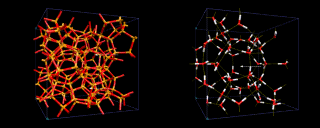Achieving Complexity
 |
Our central theme is the use and exploitation by nature of simple geometrical and topological principles to achieve structures of great complexity. The extraordinary intricacy of biological molecules discussed in later chapters is based on ring and chain formation; with interactions between these molecules and between different parts of the same molecule driving the formation of the highly complex 3D structures. In the inorganic world, we have begun to see how three dimensional structures can be generated simply by packing atoms together in the most efficient manner, but also by taking simple polyhedra which are interlinked together to form 3 D networks. We will now learn how high degrees of complexity can be introduced into these fundamentally simple structures by adding or inserting atoms in a systematic manner.
Some of the simplest examples are provided by metals such as iron and palladium which can soak up small atoms such as carbon, boron and hydrogen. These occupy 'interstitial sites' - spaces between the metal atoms as illustrated on the left. Although they are strongly chemically bonded to the metallic hosts, the characteristic metallic properties of the latter are retained (unlike the case when for example oxygen or chlorine form compounds with metals). Of much greater structural interest are those cases where the insertion of the atoms leads to distinct new structural types. Excellent examples are provided by structures based on both the octahedral and tetrahedral corner linked networks discussed earlier; indeed we will see how both form the basis for a large and diverse class of structures.
 |